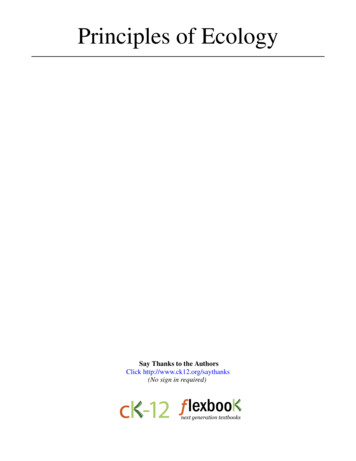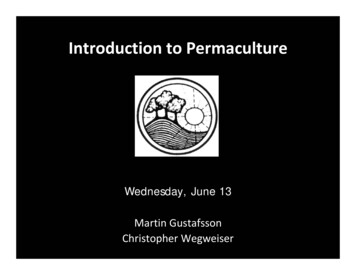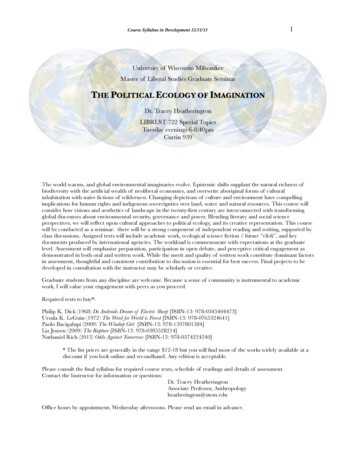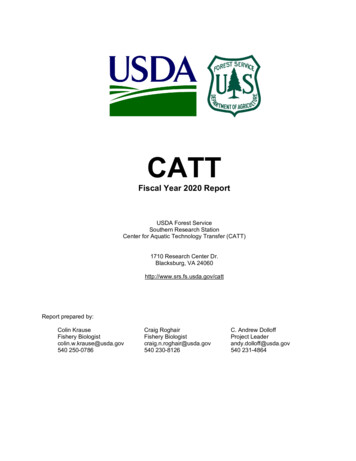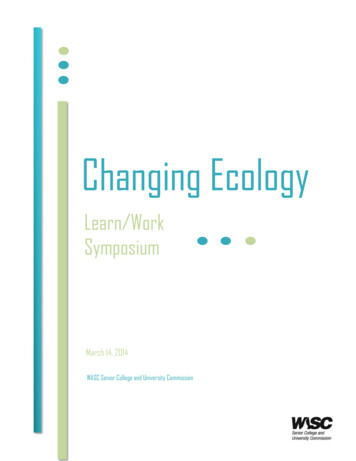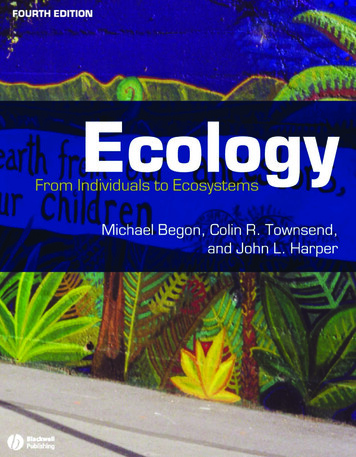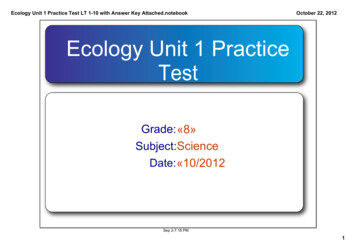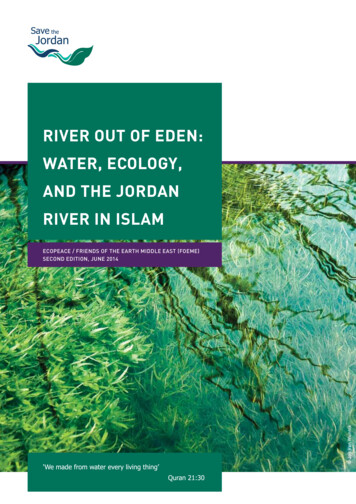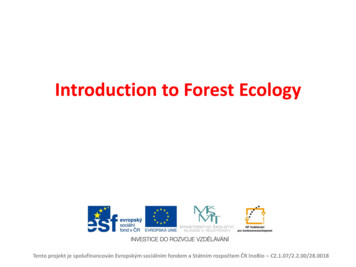
Transcription
Introduction to Forest EcologyTento projekt je spolufinancován Evropským sociálním fondem a Státním rozpočtem ČR InoBio – CZ.1.07/2.2.00/28.0018
Lesson content Forest Ecology- basic information on the course Main concepts and terminology, Importance ofecology Development of forests in Holocene Geographical distribution of forest in the world Structure and functions of forest ecosystems Ecological stability, Man and forest Ecological problems of present forestry
Basic information on the coursePrerequisites for registration:completed State BachelorExaminationTaught for the form of:full-timeForm of teaching:lecture, seminarMode of completion andcredits:Exam (6 credits)Course lecturers:prof. Ing. Jiří Kulhavý, CSc. (lecturer, examiner, instructor, administration)doc. Ing. Josef Suchomel, Ph.D. (lecturer, examiner, instructor, administration)doc. Ing. Luboš Purchart, Ph.D. (examiner, instructor, administration)
Study programme European Forestry The two-year MSc program in European Forestry is interestingin both its forms and content. It focuses not only on traditional forestry, but also on anumber of topics related to ecology, nature conservation,and sustainable development, with particular emphasis onthe latest progressive trends. The aim of the program is to provide students with a generaloverview of forestry and nature conservation and developthem theoretical and practical management skills.
What is Ecology Word comes from the Greek oikos „home“ Simply is defined as a study of the relationshipbetween organisms and their environment or the study of the factors controlling the growth anddistribution of population or the study how the nature works – includinghuman activities (Odum,1971) And many others definitions
Subdisciplines of EcologyArtficial distinction due to the fact that no single person can understandall (specialization) but important is to work together namely atecosystem , landscapes or planet level!!)–––––––Physiological Ecology (ecophysiology)Population EcologyCommunity EcologyEvolutionary EcologyEcosystem Ecology (e.g. forest, river, ponds .,Landscape EcologyProduction ecology
Ecosystem EcologyAimed at: structural and functional attributes of the system as a whole: The reciprocal influences between patterns and processes Conversion of solar energy to plant biomass through photosynthesis(primary productivity) Conversion of the energy and mass in plants to energy and mass inanimals (secondary production) The way in which energy is distributed among the organismsof the system(Food webs) Cycling of matter (CO2,water) and biogeochemical cycling of nutrients Stability (adaptation) of the system – dynamic balance How one component of the system modifies another component that isacting on it or how influences its own behavior depending on theenvironmental context – (negative or positive feedback)
Ecosytem concept and methodology(Eco)system concept needs: :- Information how the system is powered- Information what (which patterns) influences trajectory of thesystem over time (e.g. cycling of elements, enhanced,CO2concentration )- Application of matematic and modelling (system analyses)- Holistic approach ( structure and behaviour ofecosytem as a whole)- Studying of complex intractions between positive andnegative feedbecks rather than only reduction todifferent part of system (subsystem) – i.e. reductionism in ecologytypical for nineteenh century
Hiearchy of nature
The influence of temperature an precipitationon type of vegetation
Photosynthesis(Feed back princip in ecosystem level)
Water balance in rain forest
The global cycles
Global carbon pools
Global nitrogen cycle
The global water cycle
Water balance in rain forest
Functions and services provided by a forest
Why Forest EcologyNeed to acquire knowledge of:– Structure, processes and functioning in natural and managedforests– Role of soil and climat for cenoses behaviour (functioning ofecosystem)– Cycling of matter and nutrients– Trophic relations (food web), energy flow and primary andsecondary production– Biodiversity and biotic interactions in forest ecosystem,– Ecological impacts of human activities on forest ecosystems– Stress theory, principles of ecological stability– Global aspects of forest protection
Forest ecosystem Forest ecosystem – a community of species interacting amongthemselves and with the physical environment Ecosystem may be used concretely for desribing a particular place on theground or abstractly to decribe a type (e.g. Norway spruce ecosystem) Biogeocenosis is an equivalent (mostly in Europe) Main attributes are: source of energy, a supply (inputs) of row materials(e.g. nutrients in rainfall), mechanisms for storing and recycling (cycling ofmatter and nutrients), mechanisms that allow it to persist (e.g. climaticfluctuations, periodic disturbance.) Ecosystem is dynamic rather than static (time and space dynamic succession) Synergy – the whole is greater than sum of the parts Stability – it doesnt mean „no change“. Rather is analogous to thedynamic balance
Structure of forest ecosystems
ECOSYSTEM STRUCTURE AND FUNCTIONINGmaterials outside the ecosystemg r e e np l a t n sCO2O2plant-eating animals*predatorswaterdead ms outside the ecosystemsolar energyd e c o m p o s e r s(heterotrophic plants, detritophages)primary producesmineral substancessecondary producers ( phytophages, predators, reducers)movements of organic substancesmovements of mineral substances orenergyeasily decomposable dead organic substancesnot decomposable dead organic substanceslimits of the ecosystem
The influence of disturbances to hydrologicfunctions
Water balance in rain forest
Driving forces in forest ecosystems dynamic Soil and climat (solar radiation, water.)Air pollution (SO2, NOx, Ozon)Acid rainGlobal warmingVolcano eruptionMan activity and forest management
Interrelationship between ecosytem servicesand human health
Development of forests in HoloceneThe Holocene is a geologicalepoch which began at the endof the Pleistocene[1] (at 11,700calendar years BP) [2] andcontinues to the present. TheHolocene is part of theQuaternary period. Its namecomes from the Greek wordsὅλος (holos, whole or entire)and καινός (kainos, new),meaning "entirely recent".[3] Ithas been identified with thecurrent warm period, knownas MIS 1 and based on thatpast evidence, can beconsidered an interglacial inthe current ice age.
Geographical distribution of forest in the world
Basic terminology and definitions, importanceof ecology Abiotic BiodiversityBiogeochemicalcyclingBiomassBiotic factorsCarbon allocationClimate logical stabilityElasticityEnergy balance EvapotranspirationFire and forestsFood webForest certificationForest ecologyForest ecosystemGlobal ecologyGross ationInfiltrationLeaf area indexLitterfallLyzimetric watersMineralizationModellingNet ecosystem exchange Net primary productionNutrient leachingPhotosynhesisPrimary productivityResilienceSapwoodSecondary productivitySimulationSolar radiationStress factorsSucccessionSurface runoffSustainabilitySystem r balance
Ecological problems of present forestryCzech Republic Problem area 1: The reconstruction of a pure Norway spruceforest stands on sites outside of its natural area. Problem area 2: To stop soil degradation and necessity ofrehabilitation of the forest area heavily affected by airpollutatns Problem area 3: The uniform age structure of forest stands. Problem area 4: Sustainable management and protection offorest ecosystem which needs special interests – e.g.Floodplain forest ecosystem, National parks, Protected area.
LiteratureBasic reading list:WARING, R H. - RUNNING, S W. Forest ecosystems : analysis at multiple scales. 3. vyd.Amsterdam: Elsevier/Academic Press, 2007. 420 s. ISBN 978-0-12-370605-8.TOWNSEND, C R. - BEGON, M. - HARPER, J L. Essentials of ecology. 3. vyd. Malden, MA:Blackwell Pub., 2008. 510 s. ISBN 978-1-4051-5658-5.AGREN, G I. - ANDERSSON , F O. Terrestrial Ecosystem Ecology. Cambridge University Press,New York, USA: Cambridge University Press, 2012. 330 s. ISBN 978-1-107-64825-8.PERRY, David A, Ram OREN a Stephen C HART. Forest ecosystems. 2nd ed. Baltimore: JohnsHopkins University Press, c2008. ISBN 978-0-8018-8840-3.SCHULZE, Ernst-Detlef, Erwin BECK a Klaus MÜLLER-HOHENSTEIN. Plant ecology. Berlin:Springer, c2005, 702 s. ISBN 3-540-20833-x.SCHULZE, E.D. Carbon and Nitrogen Cycling in European Forest Ecosystems. 1. vyd. Berlin:Springer Verlag, 2000. 500 s. Ecological studies. ISBN 3-540-67239-7.VALENTINI, R. Fluxes of carbon, water, and energy of European forests. Berlin: Springer,c2003, 270 s. ISBN 3-540-43791-6.FÜHRER, E. Pathways to the Wise Management of Forests in Europe. Amsterdam: Elsevier,2000, 119 s.Recommended reading list:PENKA, M. - VYSKOT, M. - KLIMO, E. Floodplain Forest Ecosystem 1 : Before WaterManagement Measures. Praha: Academia, 1985. 466 s.
Other recommended literature (part 1) Apps, M.J. , Price, T.D.: Forest Ecosystems, Forest Management and the Global Carbon Cycle. NATO ASI Series, Vol.40, Springer-Verlag, 1996. 452 p.Begon, M., Harper, J.L., Townsend, C.R.: Ecology: individuals, populations and communities. ed. 2. BlackwellScientific Publications Ltd Oxford (United Kingdom). ISBN 0-632-02344-9. 1990. 957 p.Buck, L., Geisler, C.C., Schelhas, J., Wollenberg, E.: (eds.). Biological diversity: balancing interests through adaptivecollaborative management. CRC Press, Boca Raton, Florida, USA, ISBN 0-8493-0020-7. 2001. 465 p.Cote, M.: Dictionnaire De La Foresterie / Dictionary of Forestry (Hardcover). University of British Columbia Press;Bilingual edition (31 Dec 2000), ISBN-13: 978-2763777429. 2000. 744 p.Donovan, T. M. and C. W. Welden: Spreadsheet Exercises in Ecology and Evolution. Sinauer Associates, Inc.,Sunderland, MA. ISBN 0–87893–156–2. 2002. 556 p.Fuhrer, E.- Andersson, F – Farrell,E.P.: Pathways to the Wise Management of Forest in Europe, Elsevier, 2000. 119p.Handbook of the Convention on Biological Diversity: 2. ed. Montreal, Quebec (Canada). ISBN: 92-807-2280-8.2003. 937 p.Kimmins, J.P.: Forest Ecology. Prentice-Hall. 1997. 531 p.Malcolm L. Hunter JR: Maintaining Biodiversity in Forest Ecosystems. Cambridge University Press, ISBN-10:0521637686. 1999. 698 p.Maser, Chris.: Sustainable Forestry. Philosophy,Science and Economics, St. Lucie Press, 2000. 371 p.Mackenzie, A., Ball, A. S., Virdee, S. R.: Instant Notes in Ecology, BIOS Scientific Publisher Limited, 1998. 321 p.Noorallah J.: The pedosphere and its Dynamics.Vol. 1.Introduction To Soil Science and Soil Resources, SalmanProductions, Edmonton, Alberta, Canada. 1999. 315 p.
Other recommended literature (part 2) Penka,M., Vyskot, M., Klimo, E., Vašíček, F.: Floodplain Forest Ecosystem I, II. Academia Praha, 1985,1991: 628 p.Powlson S.D., Smith,P., Smith J.U.: Evaluation of Soil Organic Matter Models., NATO ASI Series, Vol.38,Springer-Verlag Berlin Heidelberg, 1996. 429 p.Rackham, O.: Woodlands. London: Collins (New Naturalist series). ISBN 0-00-720243-1. 2006. 609 p.Ricklefs R.E. and Miller G.L.: Ecology. Fourth edition, W.H. Freeman and Copany. ISBN 0-7167-2829-X(hardcover), 2000. 828 p.Robertson, G.P., Coleman D. C., Bledsoe, S.C., Sollins P.: Standard Soil Methods for Long-Term EcologicalResearch, Oxford University Press, 1999: 462 p.Schulze, D.E. (Ed.): Carbon and Nitrogen Cycling in European Forest Ecosystems, Ecological studies, Vol.142, Springer- Verlag, 2000. 500 p.Spurr, S. H., Barnes, V. B.: Forest Ecology, Third edition. John Wiley & sons, 1980. 687 p.Stanners, D., Bordeau, P.: Europes Enviroment, The Dobříš Assesment, EEA Copenhagen, 1995. 676 p.Thomas P. A. and Packham J.: Ecology of Woodlands and Forests: Description, Dynamics, and DiversityCambridge University Press, New York, NY, USA, ISBN 978-0-521-83452-0. 2007. 528 p.BRUMME R., KHANA P. K. Functioning and management of European beech ecosystems. New York:Springer, 2009. ISBN 978-3-642-00339-4.THOMAS P.A., PACKHAM J.R. Ecology of woodlands and forests: description, dynamics and diversity.Cambridge; Cambridge University Press, 2007, 528 s. ISBN 978-0-521-834520.Waring, H. R., Schlesinger, W. H.: Forest ecosystems. Concepts and Management. Academia Press, 1985.340 p.Waring, R.W., Running S.W.: Forest Ecosystems – Analysis at Multiple Scales, 2nd edition, Academic Press,1998.370 p.
Actual case studies in EuropeNew Book: Adapting to climate change in European forests – resultsof the project -Joanne Fitzgerald and Marcus Lindner (editors) –available for public on www.efi.fiCOST project EuMixFor – 2013-2016 (good discussion on Internet)Forest Condition monitoring in Europe –ICP, FOOTMON.
Articles on Web http://www.eea.europa.eu/publications/eeareport 2008 3Book: Forest Ecosystems (Perry et al. 2008) http://books.google.cz/books?id rNfoL3zH6NkC&printsec frontcover&dq bibliogroup:%22Forest Ecosystems%22&hl cs&sa X&ei KvE UsnJ4LZtAaO8oDAAw&ved 0CDMQ6AEwAA#v onepage&q&f falseBook: Plant Ecology ( Schulze et al. 2005) http://books.google.cz/books?id rDo8hLWtWzgC&printsec frontcover&hl cs&source gbs ge summary r&cad 0#v onepage&q&f false http://www.efi.int/portal/ http://www.iufro.org/ http://www.fao.org/home/en/
Book: Carbon and Nitrogen Cycling (Schulze et al. 2000) http://books.google.cz/books?id ku6QwSTDsvEC&printsec frontcover&hl cs&source gbs ge summary r&cad 0#v onepage&q&f falseBook: Spruce Monocultures in Central Europe (Klimo et al. 2000) c33 net.pdfBook: Functioning and Management of European Beech Ecosystems (Brumme et aa.200) http://books.google.cz/books?id YIkEZwZcrxwC&printsec frontcover&hl cs&source gbs ge summary r&cad 0#v onepage&q&f falseBook: Terrestrial Ecosystem Ecology (Goran et al. 2010) http://books.google.cz/books?id tBsMMPLJTLsC&printsec frontcover&dq Terrestrial Ecosystem Ecology&hl cs&sa X&ei XPY UuuxEMfGtQac1IHQCw&ved 0CD0Q6AEwAQ#v onepage&q Terrestrial%20Ecosystem%20Ecology&f falseBook: Forest Ecosystems - Analysis at Multiple Scales (Waring et al. 1998) http://books.google.cz/books?id 6YjhssXQ2AUC&printsec frontcover&dq Forest ecosystems analysis&hl cs&sa X&ei pvc UvvAOcfFswbW2IGQAg&ved 0CDEQ6AEwAA#v onepage&q Forest%20ecosystems%20-%20analysis&f falseBook: Causes and Consequences of Forest Growth Trends in Europe (Kahle et al. 2008)http://books.google.cz/books?id gSFKtxtv1kEC&printsec frontcover&dq Causes and Consequences of Forest Growth&hl cs&sa X&ei avg Ura7DojesgbnuICoAw&ved 0CDEQ6AEwAA#v onepage&q &f false
Book: Ecology of Woodlands and Forests: Description, Dynamics and Diversity(Thomas et al. 2007) http://books.google.cz/books?id 0Ntvos9aaC8C&printsec frontcover&dq Ecology of Woodlands&hl cs&sa X&ei Lvk UrTHLYKctQa0oICICg&ved 0CDMQ6AEwAA#v onepage&q Ecology%20of%20Woodlands&f false
Ecosystem Ecology Aimed at: structural and functional attributes of the system as a whole: The reciprocal influences between patterns and processes Conversion of solar energy to plant biomass through photosynthesis (primary productivity) Conversion of the energy and mass in plants
